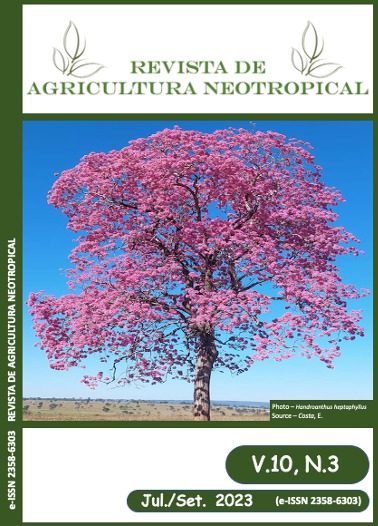INFLUENCE OF METEOROLOGICAL VARIABLES AND GEOGRAPHIC FACTORS IN THE SELECTION OF SOYBEAN LINES
DOI:
https://doi.org/10.32404/rean.v10i3.7246Keywords:
Glycine max, Reaction norm, Linear correlation, Multiple regressionAbstract
This study aimed to evaluate the influence of meteorological variables and geographic factors on the selection of soybean lines concerning grain yield in Brazil and Paraguay soybean-producing regions. The study was conducted in seven different environments: Bela Vista do Norte - PY, Palotina - PR, Mangueirinha - PR, Major Vieira - SC, Três Passos - RS, Toledo – PR, and Passo Fundo - RS. The randomized block design in an incomplete factorial scheme with six soybean genotypes (G1, G2, G3, G4, G5, and G6) was used for the experiments. The harvest occurred in the first half of March, and grain yield was measured through the total harvest of the plot and expressed in kg ha-1, with grain moisture at 13%. The climatic variables used in the study were maximum air temperature (Tmax, ºC), average air temperature (Tavg, ºC), minimum air temperature (Tmin, ºC), relative air humidity (RH, %), precipitation (Prec, mm), wind speed (WS, m/s), dew point (DP, °C), incident radiation (Rad_Inc, MJ/m²), and total radiation (RAD_OL, MJ/m²); and geographic factors were altitude (ALT), longitude (LON), and latitude (LAT). The G5 genotype with a genetic value for grain yield above the general average is the most adapted to favorable environments. Altitude had the greatest influence on the biological variability of the genotypes, with a negative correlation of moderate magnitude with grain yield. Grain yield was enhanced in environments with altitudes lower than 338 m at latitudes below 24.17S.
References
(I) Almeida, R.D., Peluzio, J.M., Afférri, F.S. 2011. Divergência genética entre cultivares de soja, sob condições de várzea irrigada, no sul do Estado Tocantins. Revista Ciência Agronômica, 42(1), 108-115.
(II) Capone, A., Santos, E.R., Santos, A.F., Dario, A.S., Barros, H.B. 2018. Produtividade e qualidade de sementes de genótipos de soja para alimentação humana introduzidos em Tocantins, na entressafra. Nucleus, 15(1), 71-84. DOI: https://doi.org/10.3738/1982.2278.2171
(III) Carvalho, C.G.P., Arias, C.A.A., Toledo, J.F.F., Almeida, L.A., Kiihl, A.S., Oliveira, M.F. 2002. Interação genótipo x ambiente no desempenho produtivo da soja no Paraná. Pesquisa Agropecuária Brasileira, 37(7), 989-1000. DOI: https://doi.org/10.1590/S0100-204X2002000700013
(IV) Cobuci, J.A., Costa, C.N., Cardoso, F.F., Braccini Neto, J., Ambrosini, D.P., Moura, M.D. 2013. Interação genótipo-ambiente na raça holandesa utilizando modelo de norma de reação. X Simpósio brasileiro de Melhoramento animal, 10, Uberaba. Anais..., Viçosa. Sociedade Brasileira de Melhoramento Animal. https://ainfo.cnptia.embrapa.br/digital/bitstream/item/97771/1/Cobuci-et-al.-SBMA-2013.pdf
(V) Costa, R., Silva, A.G., Simon, G.A., Bessa, E.R., Dias, M.O. 2019. Agronomic performance of transgenic soybean cultivars in brazilian cerrado. Acta Scientiarum. Agronomy, 41, e42713. DOI: https://doi.org/10.4025/actasciagron.v41i1.42713
(VI) FAO. FOOD AND AGRICULTURE ORGANIZATION OF THE UNITED NATIONS. Production of Soybeans: top 10 producers. 2020. https://www.fao.org/faostat/en/#data/QCL/visualize. (accessed June 24, 2022).
(VII) Ferrari, E., Paz, A., Silva, A.C. 2015. Déficit hídrico e altas temperaturas no metabolismo da soja em semeaduras antecipadas. Nativa, 3(1), 67-77. DOI: https://doi.org/10.31413/nativa.v3i1.1855
(VIII) Fritzsons, E., Mantovani, L.E., Wrege, M.S. 2016. Relação entre altitude e temperatura: uma contribuição ao zoneamento climático no estado de Santa Catarina, Brasil. Revista Brasileira de Climatologia, 18(12), 80-92. DOI: http://dx.doi.org/10.5380/abclima.v18i0.39471
(IX) Gazzoni, D.L. 2018. A soja no Brasil é movida por inovações tecnológicas. Ciência e Cultura, 70(3), 16-18. DOI: http://dx.doi.org/10.21800/2317-66602018000300005
(X) Herrera, G.C., Poletine, J.P., Brondani, S.T., Antônio, M., Barelli, A., Silva, V.P. 2020. Adaptabilidade e estabilidade de linhagens de soja na região sul do Brasil por meio de modelagem mista. Journal of Agronomic Sciences, 9, 185-202.
(XI) NASA POWER. 2022. NATIONAL AERONAUTICS AND SPACE ADMINISTRATION. Prediction of Worldwide Energy Resources. https://power.larc.nasa.gov/ (accessed June 10, 2022).
(XII) Nunes, D., Assis, J. R., Tavares, S. G., Oliveira, P. H. L. 2018. Models of reaction standards for analysis of effects of interaction genotype environment. Scientific Electronic Archives, 11 (4), 122-128
(XIII) ONU. ORGANIZAÇÃO DAS NAÇÕES UNIDAS. Perspectivas Mundiais de População 2019: Destaques, 2019. https://brasil.un.org/pt-br/83427-populacao-mundial-deve-chegar-97-bilhoes-de-pessoas-em-2050-diz-relatorio-da-onu. (accessed June 10, 2022).
(XIV) R Core Team. 2022. R: A language and environment for statistical computing. R Foundation for Statistical Computing, Vienna, Austria. http://www.R-project.org/. (accessed June 01, 2022).
(XV) Rocha, R.S., Silva, J.A.L.D., Neves, J.A., Sediyama, T., Teixeira, R.D.C. 2012. Desempenho agronômico de variedades e linhagens de soja em condições de baixa latitude em Teresina-PI. Revista Ciência Agronômica, 43(1), 154-162. DOI: https://doi.org/10.1590/S1806-66902012000100019
(XVI) Saath, K.C.O., Fachinello, A.L. 2018. Crescimento da demanda mundial de alimentos e restrições do fator terra no Brasil. Revista de Economia e Sociologia Rural, 56(2), 195-212. DOI: https://doi.org/10.1590/1234-56781806-94790560201
(XVII) Spehar, C.R., Francisco, E.R., Pereira, E.A. 2014. Yield stability of soybean cultivars in crop seasons and sowing dates at low latitude Brazilian Savannah Highlands. Journal of Agricultural Science, 153(6), 1059-1068. DOI: http://dx.doi.org/10.1017/s0021859614000781
(XVIII) Zdziarski, A.D., Todeschini, M.H., Milioli, A.S., Woyann, L.G., Madureira, A., Stoco, M.G., Benin, J. 2018. Principais grupos de maturidade da soja para aumentar a produtividade de grãos no Brasil. Crop Science, 58(3), 1155-1165. DOI: https://doi.org/10.2135/cropsci2017.09.0581
Downloads
Published
How to Cite
Issue
Section
License

This work is licensed under a Creative Commons Attribution 4.0 International License.
The authors retain the rights to the manuscripts and, therefore, are free to share, copy, distribute, perform and publicly communicate the work under the following conditions:
Acknowledge work credits in the manner specified by the author or licensor (but not in a way that suggests that you have their support or that they support their use of their work).
REVISTA DE AGRICULTURA NEOTROPICAL (ISSN 2358-6303) is under license https://creativecommons.org/licenses/by/4.0/
The State University of Mato Grosso do Sul, Sustainable Development Center of Bolsão Sul-Mato-grossense (CEDESU), of the University Unit of Cassilândia (UUC), preserves the patrimonial rights (copyright) of the published works and favors and allows their reuse under the license as mentioned above.
------------
The journal reserves the right to make normative, orthographic, and grammatical alterations in the originals, to maintain the cult standard of the language, respecting, however, the style of the authors.
Final proofs will be sent to the authors.
Published works become the property of the journal. The opinions expressed by the authors of the manuscripts are their sole responsibility.

